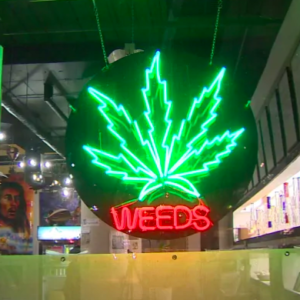In the continental United States, 11 states and the District of Columbia have legalized recreational marijuana, while 33 states and the District of Columbia have legalized the use of medical marijuana. Yet at the federal level, the government claims the right to, and does, criminalize the growing, selling and possession of marijuana in all states.
In spite of the legally opaque policy on marijuana commerce in the United States, in “The U.S. Cannabis Report 2019 Industry Outlook, New Frontier Data,” a company that touts itself as “the global source in data, analytics and business intelligence for the cannabis industry” forecasts that total U.S. sales in currently legal states are projected to grow at a compound annual growth rate of 14 percent and reach nearly $30 billion by 2025. Furthermore, annual sales of medical cannabis are projected to grow at a 17 percent compound annual growth rate through 2025, to an estimated $13.1 billion by 2025, with recreational marijuana sales projected to grow at a 16 percent compound annual growth rate, to $16.6 billion.
One of the major differences between medical and recreational marijuana is the drug’s Cannabidiol (CBD) and Tetrahydrocannabinol (THC) content, which are the active ingredients in cannabis. For recreational users, the THC content would tend to have enhanced levels, as this active ingredient is what makes people attain a psychoactive “high.” In medical marijuana, there tends to be more CBD, as this ingredient has proven to have anti-anxiety, anti-inflammatory, and anti-carcinogenic properties, and has little or no THC content, as those who need marijuana for the health benefits are not taking it for the psychoactive experiences.
Yet the optimistic growth in recreational marijuana use in the United States (an estimated 38.4 million U.S. adults reportedly consume cannabis at least once annually) is being confronted by a myriad of emerging public health challenges for the U.S. cannabis industry. Recently, the National Institute on Drug Abuse released data suggesting that 30 percent of those who use non-medical marijuana may have some degree of “marijuana use disorder,” with those who use marijuana before age 18 four to seven times more likely to develop this disorder than first-time adult users.
Researchers have estimated that 4 million people in the United States in 2015 met the criteria for marijuana use disorder (i.e., when the person cannot stop using the drug even when it interferes with their daily activities). According to the 2015-2017 National Survey on Drug Use and Health, marijuana is the third most commonly abused drug by all age groups (behind alcohol and cigarettes, respectively).
Since 2017, physicians are also seeing an increasing number of cases of cannabinoid hyperemesis syndrome. A serious ailment, this syndrome is brought on by chronic marijuana use, and results in recurrent, severe bouts of vomiting and nausea accompanied by acute pain. With legalization of marijuana in many states, patients are now willing to discuss their marijuana usage with health caregivers in these states, perhaps accounting for this increase in the number of identifiable cases.
However, the higher THC concentration level in recreational marijuana is likely a contributing factor in the emergence of this ailment. According to the National Institute on Drug Abuse, the average THC content in confiscated marijuana samples in 1990 was just under 4 percent, while in 2014, it had risen to 12 percent — a more than 300 percent increase in the psychoactive ingredient.
As of September 2019, the Centers for Disease Control and Prevention announced that of 514 self-reporting patients with lung injury associated with e-cigarette usage, approximately 77 percent report using THC-containing products, with or without nicotine-containing products, with 36 percent reporting exclusive use of THC-containing products.
As of December 10, 2019, the CDC reports that a total of 2,409 hospitalized e-cigarette or vaping, product use-associated lung injury cases have been reported to the CDC from all 50 states, the District of Columbia, and two U.S. territories (Puerto Rico and U.S. Virgin Islands). Also, 52 deaths have been confirmed in 26 states and the District of Columbia.
The CDC concludes that the latest national and state data from patient reports and product sample testing suggest THC-containing e-cigarette, or vaping, products, particularly from informal sources like friends, family, or in-person or online dealers, are linked to most of the cases and play a major role in the outbreak.
A review of the mission statements for three major cannabis industry associations (including the National Cannabis Industry Association, Cannabis Trade Federation and the American Trade Association for Cannabis & Hemp) reveals a “social responsibility” focused on the legal component of social responsibility, heavily emphasizing government regulation.
Public health issues are often found in the social and ethical realm of corporate responsibility, and in this case concern the recreational marijuana product side of the industry, including marijuana use disorder, underage use of recreational marijuana, cannabinoid hyperemesis syndrome, and THC product use in e-cigarette vaping devices, as examples.
These social and ethical responsibilities include the full scope of societal norms, values and stakeholder expectations that reflect what the cannabis industry’s consumers and the general public view as consistent with their moral rights.
For a still emerging legitimate industry, it is in the long-term, enlightened self-interest of this industry to have a positive business environment to operate in the future. To that end, the CTF appears to be the industry association that is interested in building “a dynamic network of associations and nonprofits that share a vision of creating sensible cannabis policy.”
In this case, CTF can take the lead on creating a “sensible social responsibility policy” for the cannabis industry — taking inspiration from the alcoholic beverage industry — that actively addresses the variety of public health issues beyond the legal/regulatory approaches that are associated with the THC psychoactive (and addictive) component of this product.

